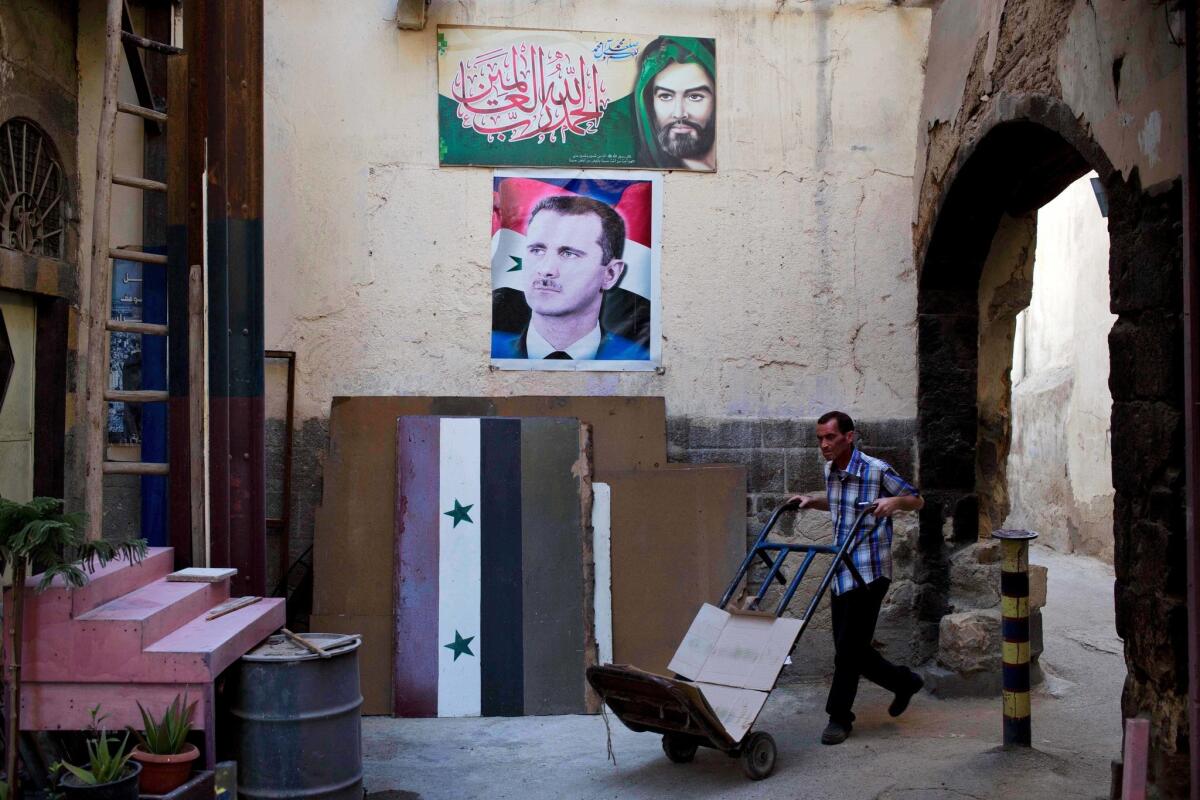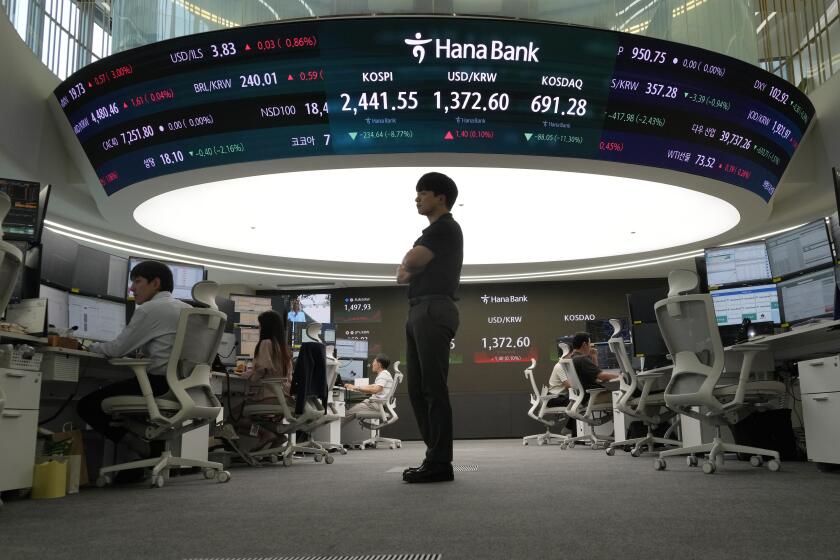How peace talks have an economic effect on ordinary Syrians

A Syrian goes about his work under a portrait of President Bashar Assad and the national flag in Damascus’ Old City on April 17, 2016.
Reporting from Chtaura, Lebanon — There is little that links this chaotic, ramshackle town near the Syrian border to the Swiss city of Geneva, where troubled peace talks aimed at ending the Mideast country’s five-year crisis hobbled along into a new week.
But Omar Laqiss, like dozens of money changers in Chtaura’s bustling central square, monitored the torturous negotiations between the Syrian government and opposition with greater attention than most journalists.
“When Geneva seemed like it was a failure four days ago, the exchange rate went down again by 10 pounds,” he explained as he fanned himself with a stack of pale-blue Syrian 500-pound notes.
Like every other victory or defeat the Syrian government sustains, the news from Geneva influenced the calculations of the brokers and Damascus currency changers who set the Syrian pound’s black market exchange rate against the U.S. dollar. The most recent major hit came in March, after Russian President Vladimir Putin announced a partial drawdown of forces buttressing Syrian President Bashar Assad’s troops.
The black market rate is a key indicator for how the Syrian economy is faring. “No one pays attention to the official exchange rate here,” said Yusef Mansour, the proprietor of another currency shop in Chtaura, with a dismissive wave of his hand.
The fighting has not been kind to the Syrian pound. The country’s infrastructure has been ravaged by war, its GDP contracted by 19% in 2015, and the oil trade has been disrupted since the second half of 2012. All of these factors have made the prewar exchange rate of 47 Syrian pounds to the dollar a distant memory, according to a World Bank report published this month.
The official exchange rate, set by Syria’s central bank, now hovers around the 450 mark.
For ordinary Syrians in government areas, the declining value of their currency means their salaries can buy less than a tenth of what they did before the crisis.
“Your average state employee makes between [30,000 to 45,000] Syrian pounds per month, depending on seniority,” Iyad Jaafari, editor of the online economic journal Iqtisad, said in a phone interview.
“This is a sizable increase from the [10,000 to 25,000] Syrian pound range from before the war, but with the currency what it is now, they’re suffering.”
Prices of goods have also skyrocketed, according to Syrian analyst Jihad Yazigi, because of the government’s reduction of subsidies of basic foodstuffs, including bread, flour and sugar.
Inflation increased by 90% in Syria in 2013, and by a further 30% in 2015, according to the World Bank. It is projected to increase by 25% in 2016 “because of continued trade disruption, shortages and sharp depreciation of the Syrian pound.”
The price hikes have pushed the government to consider printing even higher denomination bills, Jaafari added, such as a 1,000- or 2,000-pound bill.
With the economy almost at a standstill and work hard to come by, Syrians in government-controlled areas now rely on remittances from abroad. The government converts that foreign cash into Syrian pounds at a more favorable exchange rate, in an effort to encourage use of state-authorized remittance offices. But you can still get more pounds for your dollar on the black market -- 520 Syrian pounds to the dollar.
And there lies the key to an important source of foreign currency reserves -- not to mention profit -- for the Syrian government.
“The central bank takes the dollars from those remittances at the lower rate, but then sells them or exchanges them through its network at the black-market rate, pocketing the difference,” explained Jaafari.
“It makes the government a major player in the currency exchange. We estimate it makes anywhere from 2 to 3 million dollars per day.”
Aid organizations also bolster the government’s foreign reserves: Aid is disbursed in dollars, then converted into Syrian pounds for use in the local market.
That, along with the reported financial assistance the government receives from Iran, provides the central bank with a stash of foreign currency that it can pump into the market to stabilize the Syrian pound when needed. Plus, in the strange calculus of war, the government sometimes saves money when it loses territory.
“When the pound falls quickly, they’re able to make it steady by injecting the dollars they have accumulated,” Jaafari said.
Even here, however, there is room for those close to the government to profit.
“Let’s say the central bank announces it will pump dollars into the market for a two-week period at a lower rate. Currency exchangers can sell these [dollars] to the public at that reduced rate, but they limit the amount people can change to 200 dollars per person and add a lot of administrative hurdles,” said Jaafari. By the time the two-week period has ended, he explained, those currency exchangers still have a lot of dollars on their hands, which they can then sell at the black market rate.
“There are blocs of currency brokers who are considered to be partners with corrupt members of the central banks, as well as blocs in opposition-controlled areas that try to play on the behavior of the central bank,” Jaafari said.
The profits, according to Yazigi, could well be in the millions.
“There are people who are making money out of this … who have left their regular jobs to do this,” he said.
But the government may no longer have enough foreign reserves to stanch the pound’s bloodletting, according to the World Bank report. It estimated “total international reserves had declined from 20 billion at [the end of] 2010 to 0.7 billion by the end of 2015.”
“This is very dangerous,” said Jaafari, explaining that the government usually injected anywhere from $20 million to $50 million to stop a run on the Syrian pound.
“What these numbers mean is that it can’t do this for very much longer,” he said. “There are theories we may see starvation in Damascus.”
Bulos is a special correspondent.
More to Read
Sign up for Essential California
The most important California stories and recommendations in your inbox every morning.
You may occasionally receive promotional content from the Los Angeles Times.











